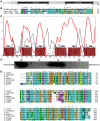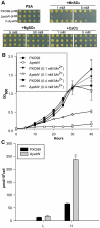A novel manganese efflux system, YebN, is required for virulence by Xanthomonas oryzae pv. oryzae
- PMID: 21789199
- PMCID: PMC3136493
- DOI: 10.1371/journal.pone.0021983
A novel manganese efflux system, YebN, is required for virulence by Xanthomonas oryzae pv. oryzae
Abstract
Manganese ions (Mn(2+)) play a crucial role in virulence and protection against oxidative stress in bacterial pathogens. Such pathogens appear to have evolved complex mechanisms for regulating Mn(2+) uptake and efflux. Despite numerous studies on Mn(2+) uptake, however, only one efflux system has been identified to date. Here, we report on a novel Mn(2+) export system, YebN, in Xanthomonas oryzae pv. oryzae (Xoo), the causative agent of bacterial leaf blight. Compared with wild-type PXO99, the yebN mutant was highly sensitive to Mn(2+) and accumulated high concentrations of intracellular manganese. In addition, we found that expression of yebN was positively regulated by Mn(2+) and the Mn(2+)-dependent transcription regulator, MntR. Interestingly, the yebN mutant was more tolerant to methyl viologen and H(2)O(2) in low Mn(2+) medium than PXO99, but more sensitive in high Mn(2+) medium, implying that YebN plays an important role in Mn(2+) homoeostasis and detoxification of reactive oxygen species (ROS). Notably, deletion of yebN rendered Xoo sensitive to hypo-osmotic shock, suggesting that YebN may protect against such stress. That mutation of yebN substantially reduced the Xoo growth rate and lesion formation in rice implies that YebN could be involved in Xoo fitness in host. Although YebN has two DUF204 domains, it lacks homology to any known metal transporter. Hence, this is the first report of a novel metal export system that plays essential roles in hypo-osmotic and oxidative stress, and virulence. Our results lay the foundations for elucidating the complex and fascinating relationship between metal homeostasis and host-pathogen interactions.
Conflict of interest statement
Figures









Similar articles
-
The YebN Leader RNA Acts as a Mn2+ Sensor Required for the Interaction of Xanthomonas oryzae and Rice.Mol Plant Microbe Interact. 2018 Sep;31(9):932-939. doi: 10.1094/MPMI-02-18-0043-R. Epub 2018 Aug 8. Mol Plant Microbe Interact. 2018. PMID: 29522378
-
Role of DetR in defence is critical for virulence of Xanthomonas oryzae pv. oryzae.Mol Plant Pathol. 2016 May;17(4):601-13. doi: 10.1111/mpp.12305. Epub 2015 Oct 19. Mol Plant Pathol. 2016. PMID: 26315668 Free PMC article.
-
Xanthomonas oryzae pv. oryzae requires H-NS-family protein XrvC to regulate virulence during rice infection.FEMS Microbiol Lett. 2016 May;363(10):fnw067. doi: 10.1093/femsle/fnw067. Epub 2016 Mar 20. FEMS Microbiol Lett. 2016. PMID: 27001973
-
Molecular determinants of disease and resistance in interactions of Xanthomonas oryzae pv. oryzae and rice.Microbes Infect. 2002 Nov;4(13):1361-7. doi: 10.1016/s1286-4579(02)00004-7. Microbes Infect. 2002. PMID: 12443901 Review.
-
Specificity of metal sensing: iron and manganese homeostasis in Bacillus subtilis.J Biol Chem. 2014 Oct 10;289(41):28112-20. doi: 10.1074/jbc.R114.587071. Epub 2014 Aug 26. J Biol Chem. 2014. PMID: 25160631 Free PMC article. Review.
Cited by
-
Role of transition metal exporters in virulence: the example of Neisseria meningitidis.Front Cell Infect Microbiol. 2013 Dec 23;3:102. doi: 10.3389/fcimb.2013.00102. eCollection 2013. Front Cell Infect Microbiol. 2013. PMID: 24392357 Free PMC article.
-
Genome-Scale Metabolic Model of Xanthomonas phaseoli pv. manihotis: An Approach to Elucidate Pathogenicity at the Metabolic Level.Front Genet. 2020 Aug 11;11:837. doi: 10.3389/fgene.2020.00837. eCollection 2020. Front Genet. 2020. PMID: 32849823 Free PMC article.
-
RaxM regulates the AvrXa21 (RaxX)-mediated immune response.Mol Plant Pathol. 2018 Nov;19(11):2363-2369. doi: 10.1111/mpp.12703. Epub 2018 Sep 4. Mol Plant Pathol. 2018. PMID: 30011129 Free PMC article.
-
Manganese Utilization in Salmonella Pathogenesis: Beyond the Canonical Antioxidant Response.Front Cell Dev Biol. 2022 Jul 12;10:924925. doi: 10.3389/fcell.2022.924925. eCollection 2022. Front Cell Dev Biol. 2022. PMID: 35903545 Free PMC article. Review.
-
Local-to-global signal transduction at the core of a Mn2+ sensing riboswitch.Nat Commun. 2019 Sep 20;10(1):4304. doi: 10.1038/s41467-019-12230-5. Nat Commun. 2019. PMID: 31541094 Free PMC article.
References
-
- Papp-Wallace KM, Maguire ME. Manganese Transport and the Role of Manganese in Virulence. Annu Rev Microbiol. 2006;60:187–209. - PubMed
Publication types
MeSH terms
Substances
Associated data
- Actions
- Actions
LinkOut - more resources
Full Text Sources

